Scatter Chart
The topics in this section describe the features available in the Scatter Chart dashboard item, and provide information on how to create and customize scatter charts in the BI Dashboard.
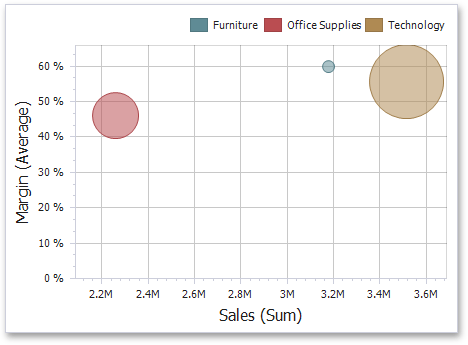
The Scatter Chart dashboard item visualizes summaries using three dimensions: the X-axis, the Y-axis and the size of data points.

The Scatter Chart dashboard item can display point labels and tooltips that show information on data points. To see a tooltip, hover over the required point.
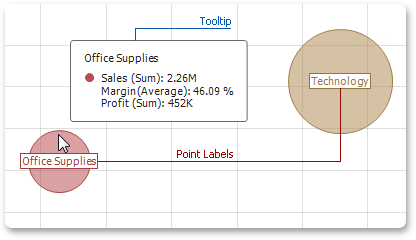
Providing Data
The Dashboard Designer allows you to bind various dashboard items to data in a virtually uniform manner.
The only difference is in the data sections that the required dashboard item has. This topic describes how to bind a Scatter Chart dashboard item to data in the Designer.
Binding to Data in the Designer
The image below shows a sample Scatter Chart dashboard item that is bound to data.

To bind the Scatter Chart dashboard item to data, drag and drop a data source field to a placeholder contained in one of the available data sections. A table below lists and describes Scatter Chart data sections.
| Section | Description |
|---|---|
|
X-Axis |
Contains the data item against which the X- coordinates of data points are calculated. |
|
Y-Axis |
Contains the data item against which the Y- coordinates of data points are calculated. |
|
Weight |
Contains the data item whose values are used to calculate the weight of data points. |
|
Arguments |
Contains Data Items providing scatter chart arguments that are used to create data points. |
Transposing X and Y axis
The Scatter Chart dashboard item provides the capability to transpose its axes. In this case, the data item contained in the X-Axis section is moved to the Y-Axis section, and vice versa.

To transpose the selected Scatter Chart dashboard item, use the Transpose button in the Home ribbon tab.

Interactivity
This section describes features that enable interaction between the Scatter Chart and other dashboard items. These features include Master Filtering and Drill-Down.
Master Filtering
The Dashboard allows you to use any data aware dashboard item as a filter for other dashboard items (Master Filter).
The Scatter Chart dashboard item supports filtering by points that correspond to specific argument values or their combinations.
When Master Filtering is enabled, you can click a point (or multiple points by holding down the CTRL key) to make other dashboard items only display data related to the selected point(s).
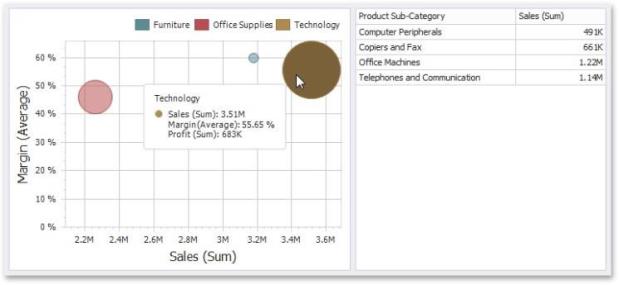
To reset filtering, use the Clear Master Filter  button in the Chart's caption area, or the Clear Master Filter command in the context menu.
button in the Chart's caption area, or the Clear Master Filter command in the context menu.
Drill-Down
The built-in drill-down capability allows you to change the detail level of data displayed in dashboard items on the fly.
When drill-down is enabled, you can click a point to view the details
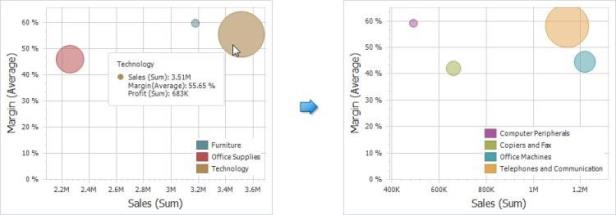
When Master Filtering is enabled, you can view the details by double-clicking a point.
Drill-down requires that the Arguments section contain several dimensions, from the least to the most detailed dimension.
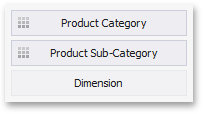
To enable drill-down, click the Drill Down button in the Data Ribbon tab (or the  button if you are using the toolbar menu).
button if you are using the toolbar menu).
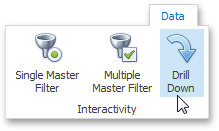
To return to the previous detail level (drill up), use the Drill Up  button in the caption of the Scatter Chart dashboard item, or the Drill Up command in the context menu.
button in the caption of the Scatter Chart dashboard item, or the Drill Up command in the context menu.
Coloring
Certain dashboard items provide the capability to color dashboard item elements by associating dimension values/ measures and specified colors. You can choose whether to use a global color scheme to provide consistent colors for identical values or specify a local color scheme for each dashboard item.
By default, the Scatter Chart dashboard item does not color its arguments. If necessary, you can change this behavior. For instance, the image below displays the Scatter Chart dashboard item whose Product Category points are colored by hue.
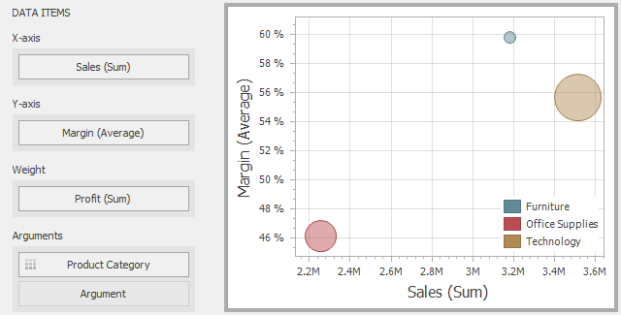
Legend
A legend is an element of a scatter chart that identifies chart points (for instance, colored points corresponding to argument values).
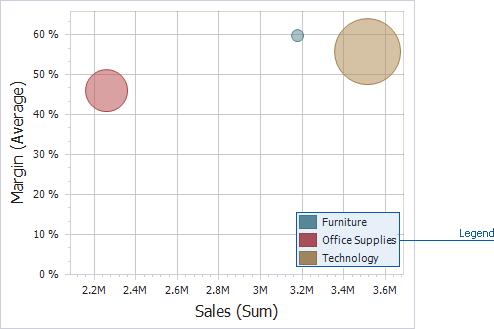
This topic describes how to customize various legend settings.
Visibility
You can specify whether or not a chart should display a legend.
In the Designer, use the Show Legend button in the Legend section of the Design Ribbon tab.
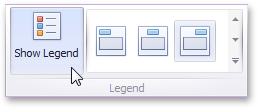
Position and Orientation
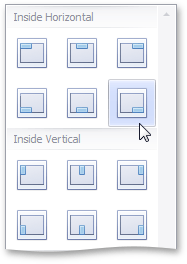
To specify the legend's position and orientation, select one of the predefined options from the gallery in the Design Ribbon tab.
Axes
Scatter Chart X and Y-axes are numerical axis of values. You can specify various axes settings to change visual data presentation.
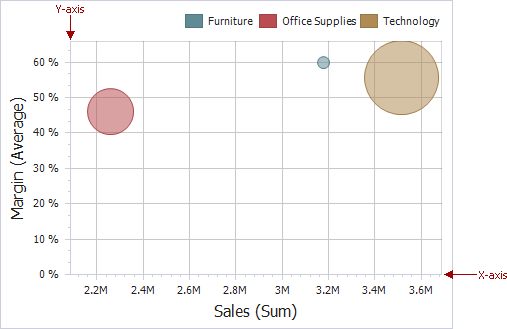
To access X and Y-axis settings, use the X-Axis Settings/Y-Axis Settings buttons in the Diagram section of the Design Ribbon tab.
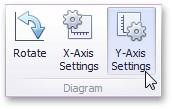
This will invoke the X-Axis Settings/Y-Axis Settings dialog.
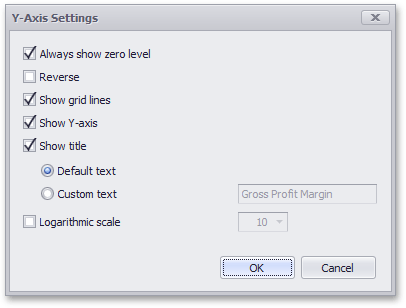
In this dialog, you can specify the following settings:
Always show zero level: Specifies whether or not the axis' zero level is visible. If this option is unchecked, the visible axis range is defined based on the values plotted in the chart. Note that the X-Axis setting dialog does not contain this option.
Reverse: Allows you to reverse the axis. If the axis is reversed, its values are ordered from top to down.
Show grid lines: Allows you to hide and show grid lines for the axis.
Show axis: Allows you to hide and show the axis.
Show title: Allows you to hide and show the axis title. You can choose whether to use the default text or specify a custom string.
Logarithmic scale: Specifies whether or not the axis should display its numerical values using a logarithmic scale. The combo box next to this option allows you to select the logarithmic base from one of the predefined values.
Orientation
You can rotate the Scatter Chart so that the X-axis becomes vertical, and the Y-axis becomes horizontal. To rotate a Chart in the Designer, use the Rotate button in the Diagram section of the Design Ribbon tab.

Labels
The Scatter Chart display can display point labels that contain descriptions for data points, and provide tooltips with additional information.

Point Labels
To manage the visibility of point labels, click the Point Labels button in the Design ribbon tab.
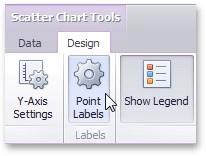
In the invoked Point Label Settings dialog, enable the Show point labels check box to show point labels.
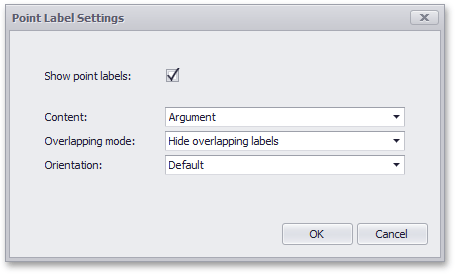
You can specify the following settings for point labels:
-
Content: Specifies the type of content displayed within point labels. You can select one of the following options:
-
Values: Point labels show summary values from X and Y-axes.
-
Argument: Point labels show argument values.
-
Argument and values: Point labels show argument values and corresponding summary values.
-
Weight: Point labels show the weight summary value.
-
Argument and weight: Point labels show the argument value and the corresponding weight summary value.
-
-
Overlapping mode: Specifies the label overlap mode. The following options are available:
-
Hide Overlapping labels: If two or more labels overlap, some of them are automatically hidden to avoid overlapping.
-
None: The overlapping resolving algorithm is disabled.
-
Reposition overlapping labels: The default algorithm to re-position point labels in a random way, and avoid overlapping labels.
-
-
Orientation: Specifies the orientation of point labels. The following options are available:
-
Default: A point label is displayed in its default orientation.
-
Rotate to the Right: A point label is rotated 90 degrees clockwise.
-
Rotate to the Left: A point label is rotated 90 degrees counter clockwise.
-